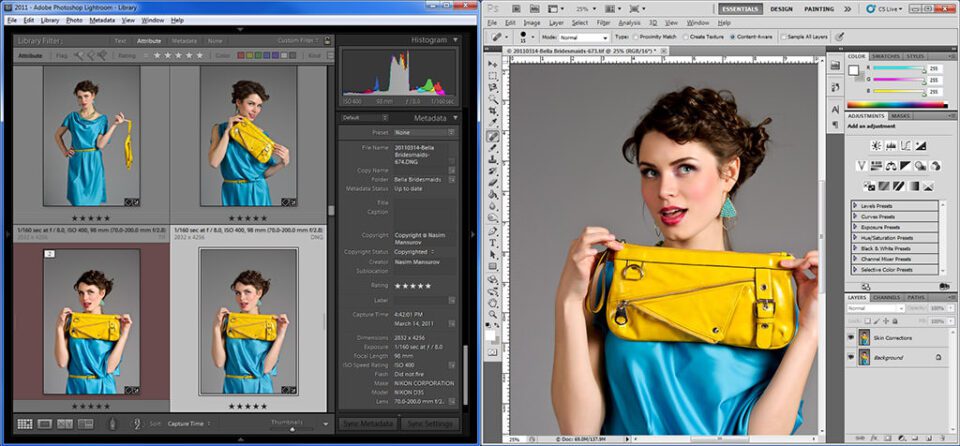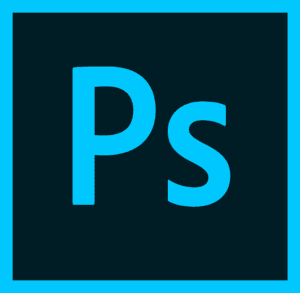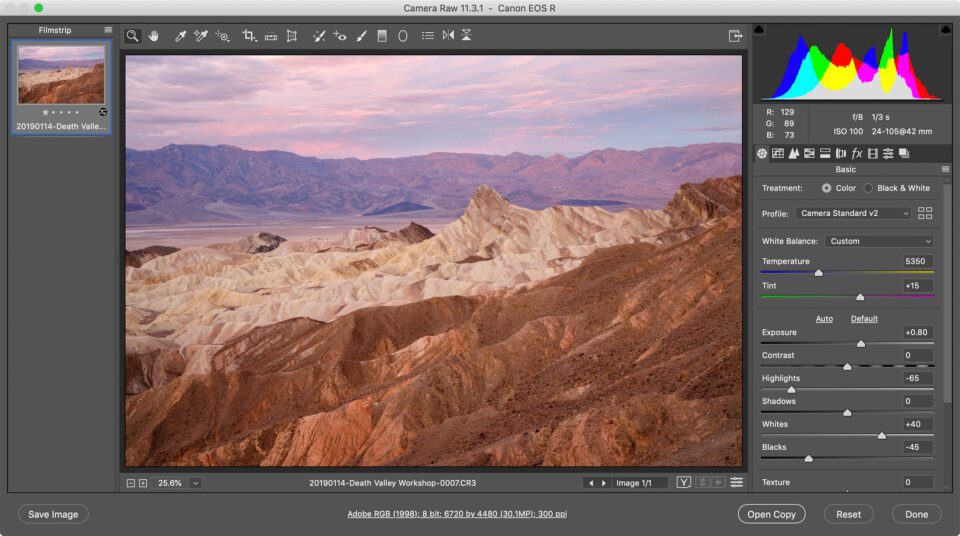What Is The Difference Between Photoshop And Lightroom

One question that keeps coming from our readers all the time is virtually Lightroom vs Photoshop – many beginners do non know differences between Lightroom and Photoshop and have a hard time choosing which one to get beginning. In this article, I will show the main differences between these two software packages from Adobe, what they are used for and what you tin can do in Photoshop that you cannot in Lightroom.

What is Photoshop?
 Photoshop was originally created as a tool for elementary image editing, which since 1990 has grown into a monster software suite with many functions and capabilities to adjust graphic designers, architects, animators, publishers, photographers and even 3D artists. Think of it as a Cadillac of paradigm editing with unlimited potential that can grow not merely with software updates and upgrades simply besides with special plugins known as "filters" from Adobe and 3rd-political party software companies.
Photoshop was originally created as a tool for elementary image editing, which since 1990 has grown into a monster software suite with many functions and capabilities to adjust graphic designers, architects, animators, publishers, photographers and even 3D artists. Think of it as a Cadillac of paradigm editing with unlimited potential that can grow not merely with software updates and upgrades simply besides with special plugins known as "filters" from Adobe and 3rd-political party software companies.
Want to run up multiple photographs into a unmarried panorama? Or create a High Dynamic Range photograph? Or get rid of skin blemishes? Or mayhap make a person await taller, shorter, thinner or fatter? Yup, Photoshop can do all that; and much much more than. It would be pointless to try to listing what Photoshop can exercise because it would probably be a never-ending list. The term "Photoshopped" is at present a part of our daily jargon because we are constantly exposed to altered images that might look realistic while beingness imitation – that's the ability of Photoshop.
What is Lightroom?
 The full name for Lightroom is "Adobe Photoshop Lightroom", which may audio confusing, because it contains the word "Photoshop". In a way, information technology makes sense, considering Lightroom can be considered a subset of Photoshop with specific functionality that Photoshop does not and probably will never have. Information technology was created for the main purpose of managing a large number of images, keeping them organized in one identify. Photoshop is a very advanced image editing tool, but when you edit hundreds of images, keeping them organized becomes a problem over fourth dimension.
The full name for Lightroom is "Adobe Photoshop Lightroom", which may audio confusing, because it contains the word "Photoshop". In a way, information technology makes sense, considering Lightroom can be considered a subset of Photoshop with specific functionality that Photoshop does not and probably will never have. Information technology was created for the main purpose of managing a large number of images, keeping them organized in one identify. Photoshop is a very advanced image editing tool, but when you edit hundreds of images, keeping them organized becomes a problem over fourth dimension.
Before I started using Lightroom, my photography workflow solely consisted of Adobe Photographic camera RAW (which allows opening, manipulating and converting RAW files) and Photoshop (which I used to fine-melody images before saving them into my difficult bulldoze). It was a circuitous, cumbersome and inefficient process, even afterward I semi-automated it through a batch process in Photoshop. The biggest challenge was organizing edited images in my hard drive, sorting and cataloging them. I am non even going to talk almost finding images, because it was an incommunicable chore that required reviewing thousands of thumbnails and image metadata in society to find what I was looking for. Every bit my file catalog grew, I realized that I had to find a better manner to organize my photographs. And that's when I discovered Lightroom.
Lightroom is a database-driven image direction software that automatically reads prototype metadata (such every bit camera make and model, date/fourth dimension captured, discontinuity, shutter speed, ISO, white residue and more), known as EXIF and writes information about each photograph in a new database known as "catalog". Every bit images are imported, Lightroom has built-in functionality to add boosted information to each paradigm, allowing you to tag images with specific keywords, flags and star ratings. This makes it very easy to sort through hundreds of images and pick the best ones, edit them selectively or in batches, then consign the best images directly into websites like Flickr and Facebook. This type of tagging and indexing is not available in Photoshop, because Photoshop does not keep a database with cataloged images.
In improver to media management capabilities, Lightroom contains a set of tools that allow photographers to dispense images. In short, think of Photoshop equally an image editing tool while Lightroom is an image direction tool with some limited paradigm editing capabilities.
Lightroom Epitome Editing Capabilities
Lightroom has a specific set up of tools that arrive easy to edit and dispense images. Here is a list of tools available in Lightroom'south Develop Module:
- Histogram and Tools Sub-Modules: Histogram, Crop & Straighten, Spot Removal, Ruddy Eye Correction, Graduated Filter, Radial Filter, Adjustment Brush.
- Basic Sub-Module: Treatment: Color and Black & White; Camera Profiles; White Residuum: Temp and Tint; Tone: Exposure, Dissimilarity, Highlights, Shadows, Whites and Blacks; Presence: Texture, Clarity, Dehaze, Vibrance and Saturation.
- Tone Curve Sub-Module: Region: Highlights, Lights, Darks, Shadows; Indicate Curve.
- HSL / Color / B&W Sub-Module: Hue, Saturation, Luminance.
- Split Toning Sub-Module: Highlights: Hue, Saturation and Balance; Shadows: Hue and Saturation.
- Detail Sub-Module: Sharpening: Amount, Radius, Detail and Masking; Noise Reduction: Luminance, Detail, Contrast, Color, Detail and Smoothness.
- Lens Corrections Sub-Module: Lens Profile: Remove Chromatic Abnormality, Enable Contour Corrections; Manual: Distortion, Defringe and Vignetting.
- Transform Sub-Module: Automobile Transform, Transform: Vertical, Horizontal, Rotate, Aspect, Scale, Ten Outset, Y Offset.
- Furnishings Sub-Module: Post-Crop Vignetting: Fashion, Amount, Midpoint, Roundness, Feather, Highlights; Grain: Corporeality, Size, Roughness.
- Camera Calibration Sub-Module: Procedure Version, Shadows: Tint, Cerise Primary: Hue and Saturation, Light-green Master: Hue and Saturation, Bluish Primary: Hue and Saturation.
Every bit you lot can see, the list of tools is rather long – from cropping and changing bones exposure to fixing lens-specific problems. Hither is a screenshot of the Histogram / Bones sub-modules:

Specific changes can exist saved equally Presets and applied to a grouping of images. As Adobe develops new versions of Lightroom, new sub-modules and other sub-module specific features become bachelor.
In addition to the image editing capabilities highlighted to a higher place, Lightroom also has built-in modules for creating slideshows, printing images, exporting image galleries for the web and more.
Photoshop Image Editing Capabilities
All of the above Lightroom epitome editing capabilities are automatically included in Adobe Camera RAW, which fires upwardly when a RAW epitome is opened from Photoshop. While it looks a little different than Lightroom, every single function is mirrored in Camera RAW. When Adobe releases updates to Lightroom, it too releases updates to Camera RAW at the same time, so fifty-fifty minor things like Lens Profiles become refreshed in both. Here is a screenshot of the Camera RAW panel:

And hither is a comparison of the exposure sub-module:

Equally you can see, both take exactly the same functionality.
To sum it upward, everything you can do in Lightroom can be done in Photoshop, plus much more. Some photographers use Adobe Bridge with Photoshop as role of their workflow without Lightroom. While Span has some of the Lightroom functionality, information technology is non a database/catalog organization. Think of information technology as a browser or file managing director. Searching for an epitome requires going through all files, which could take a long time, whereas a similar search in Lightroom could be done in a matter of seconds – again considering Lightroom'due south database is optimized for searching. If yous have been using Adobe Bridge, try Lightroom and you lot will never go back to Bridge again.
Which to Start With – Lightroom or Photoshop?
The real question is, which software should one kickoff with – Lightroom or Photoshop? Since all of Lightroom's image manipulation tools are already available in Photoshop, wouldn't it make sense just to start using Photoshop? I always recommend to kickoff off with Lightroom for the following reasons:
- Lightroom is easier to learn than Photoshop.
- Lightroom already contains a large number of mail-processing tools (every bit shown above) – good for 90%+ of editing tasks.
- Lightroom volition help you in establishing a solid photography workflow procedure.
- Lightroom makes you more than efficient because you can go through and procedure many photos speedily, without having to deal with opening and closing files.
- Lightroom will continue you organized by cataloging all of your images in i identify, making information technology like shooting fish in a barrel to find and work with images.
- As a file and media management tool, Lightroom allows creating folders and sub-folders in your hard drive and tin mass-rename files using templates.
- Editing images in Lightroom is non-subversive, which means that the original file never gets permanently changed, whereas Photoshop is a mix of destructive and not-subversive editing.
- Unless separate layers are kept for every change, Photoshop does not keep historical changes. With Lightroom, you lot can become back and restore earlier settings after making changes.
- Lightroom can display image metadata as an overlay as you lot edit photos. Photoshop cannot exercise that once an image is opened.
I am certain there are many other advantages to using Lightroom, just these are the ones I personally find important.
At present, call up when I said, "I always recommend to showtime off with Lightroom"? This ways that you lot should somewhen starting time exploring Photoshop. If you are planning to do whatever serious editing, yous will take to get into Photoshop to be able to do things you cannot do in Lightroom. For case, removing objects in Lightroom is very limited and slow, whereas Photoshop'southward healing tools are very powerful in comparing. There are many other tools that are simply not available in Lightroom, such as the ability to focus stack images, or working with different layers.
Which Version to Purchase
Unfortunately, Adobe has discontinued the retail versions of Lightroom and Photoshop, and then y'all tin can longer buy them separately. The simply fashion to buy Lightroom or Photoshop today is to subscribe to Adobe's Creative Cloud platform. We accept written a number of articles at PL criticizing Adobe's subscription platform, but the company is not going to dorsum out of its decision and volition no longer provide support for any retail versions of the software.
You tin subscribe to Adobe Creative Deject plans through Adobe's website, or through our trusted partner B&H Photograph Video below:
- Adobe Creative Cloud Photography Programme (12 Calendar month Subscription, includes Photoshop) ($119.88)
- Adobe Creative Cloud Photography Plan at Adobe.com ($ix.99 per calendar month)
If you are just getting into photography, only want to explore an alternative image editing software without having to pay a monthly subscription fee, then yous might want to check out Adobe Photoshop Elements. It has many of the features, tools, and filters from Photoshop, with some stripped out features. Think of Photoshop Elements equally a light version of Lightroom and a light version of Photoshop combined. While y'all tin can apply Photoshop Elements to organize, edit, impress and publish photographs, it can also nicely integrate with Lightroom if you choose to use Lightroom'due south epitome organization features instead. If you lot only have pictures of your family unit and occasional landscapes & nature photos, so Photoshop Elements is a good choice. If you are wondering about differences betwixt Elements and Lightroom, see our Photoshop Elements vs Lightroom article.
The best photography workflow, in my stance, involves both image editing and image management software working hand-in-hand as Lightroom and Photoshop exercise. When you come beyond an image in Lightroom that y'all demand to edit in Photoshop, yous only right-click the image and click on "Edit in Adobe Photoshop". The image opens up in Photoshop and one time yous are done with all the changes, saving the image imports that new prototype back into Lightroom and this kind of two-manner communication is automatic. No demand for imports or exports. The good news is that you tin can simultaneously work in both, which speeds up your workflow even more. The bad news is that you will need to pay Adobe $9.99 per month to be able to do that. Some other bad news is that once yous get Photoshop, you will probably need to get additional instruction and perchance 3rd-party tools as well, which translates to additional investment of time and money.
At the finish of the twenty-four hours, good and reliable software is important for every photographer. Start off with Lightroom and once y'all learn its functionality and its limitations, start using Photoshop to open upwardly new doors in front of y'all. Merely be warned – Photoshop can be both a rewarding and frustrating experience. It is a complex piece of software that has a significant learning curve.
What Is The Difference Between Photoshop And Lightroom,
Source: https://photographylife.com/photoshop-vs-lightroom
Posted by: parkerhicle1955.blogspot.com


0 Response to "What Is The Difference Between Photoshop And Lightroom"
Post a Comment